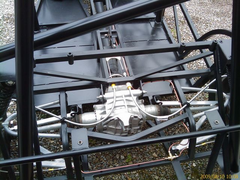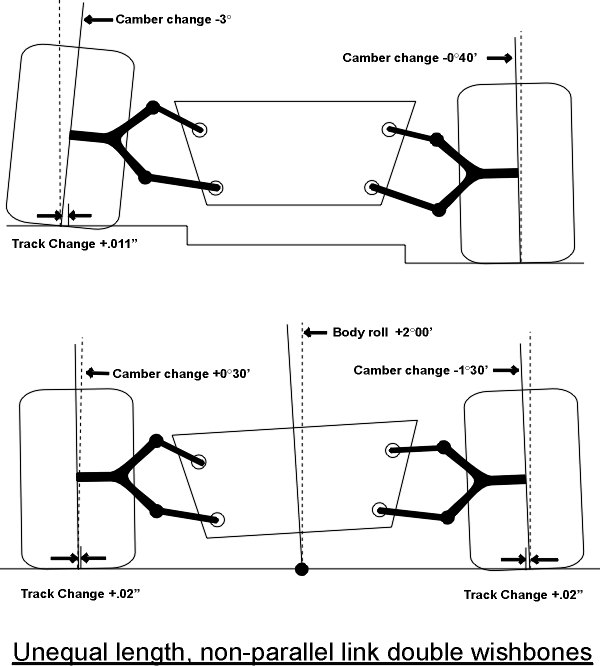Jacko
You can see it in this photo of his car


Description
[Edited on 15/4/13 by jacko]

Reading other threads about the rear suspension geometry, on the pre R chassis, has anyone
moved the top wishbone pick up onto the bottom shock mounting? If so did it improve matters?
What handling issues does it cause? I can't say I've noticed any issues, but then I'm not competing in any form of motorsport.
Stu
Fo you mean moving the upper wishbone outer pickup up to where the shock mounts in the upright?
If so, I considered doing this, but ended up selling the car before I tried it. My thinking was it would improve negative camber gain in roll and it
was potentially easier than modifying the chassis pick up points.
I did wonder if it could be done by modifying the upper wishbone to pick up outside the upright using the lower shock bolt, possibly using a rod end
instead of the bush arrangement.
It would also be useful to get more suspension travel by fitting a longer shock, maybe further down the upright. I always found the car topped out or
bottomed out depending on setup on uneven roads.
Are you going to have a go...I'd be really interested to see if it improves things.
Yes people have and I have a u2u conversation with an LCB member but can't check who with right now as I'm on the phone, I'll reply again as to who did it and also has very interesting drawings of the changes it caused
Just checked, 'Mave' is his username...
Have a search on here or search youtube for 'positive camber in roll' for a video of the behaviour of doing exactly what you've
described...
However, in the thread I was told that I was doing it wrong as moving the rear suspension going from full droop and fully compressed does not imitate
'in roll'
quote:
Originally posted by yellowcab
Just checked, 'Mave' is his username...
Have a search on here or search youtube for 'positive camber in roll' for a video of the behaviour of doing exactly what you've described...
However, in the thread I was told that I was doing it wrong as moving the rear suspension going from full droop and fully compressed does not imitate 'in roll'
What don't understand is though (and please forgive my stupidity)
From my video, moving the upper wishbone outer mounting point up to the shock absorber bolt makes the matter worse, as when the suspension is
compressed the camber goes off the scale (positively)
Unless I don't get it lol
Mookaloid moved the inner lower arm down if that helps
Jacko
You can see it in this photo of his car


Description
[Edited on 15/4/13 by jacko]
quote:
Originally posted by jacko
Mookaloid moved the inner lower arm down if that helps
Jacko
You can see it in this photo of his car
Description
[Edited on 15/4/13 by jacko]

quote:
Originally posted by yellowcab
What don't understand is though (and please forgive my stupidity)
From my video, moving the upper wishbone outer mounting point up to the shock absorber bolt makes the matter worse, as when the suspension is compressed the camber goes off the scale (positively)
Unless I don't get it lol
This illustration shows the roll effect on camber quite well. If you think in terms of the arc through which the wishbones travel, the effective
length of the bones change as the follow the arc. Ideally you want to increase negative camber through the suspension travel. By positioning of the
pivot points and bone length as shown, the upper bone's effective length shortens faster than that of the lower bone. The effect is the top of
the wheel is pulled inwards quicker so gaining negative camber.
ETA...you can also see how negative camber increases in static suspension travel and how that translates to maintaining camber in roll. This is the
desired effect to maintain the maximum tyre contact in cornering as the car rolls.

[Edited on 15/4/13 by nick205]
[Edited on 15/4/13 by nick205]
Nick you've explained that impeccably! I totally get it now...
I'll have a look to see if I can move my upper outer mounting up, I wonder if I will notice a difference by moving it up an inch (in between the
current hole, and the shock absorber hole) as that way, it doesn't mean faffing around with trying to relocate the bottom of the shock
absorber...
You reckon that will make any improvement?
I hope Marcel doesn't mind me sharing, but here is what he found when moving his upper wishbone, outer mounting point UP to the lower shock
absorber hole, and relocating the shock absorber altogether...




Looking at those images, the change in shock position reflects the change between the original Indy and later Indy R chassis (I'm sure there were also changes to the pick up point locations as well).
Hi.
But you are only simulating the camber change with the chassis parallel to the ground. Put the chassis into a 1Deg roll situation. The upper and lower
pick up points have moved in relation to the vertical axis.
Your looking to improve the camber change in roll / cornering so replicate that situation.
Cheers Matt
Hi Matt,
That has been recognised in the discussion and hopefully highlighted by the illustration as well.
Thinking about Yellowcabs test video below, the roll element would be easy to replicate by placing a level across the chassis pickup points and then
propping up the other side to achieve the roll angle. Going deeper, the front suspension and weight distribution would all contribute to the overall
effect, but this would at least give an indication of rear camber behaviour in roll.
Yellowcab - do you still have the car up on blocks to test this? Having been an Indy owner I'm really quite intrigued to know if this would have
improved the rear end.
http://www.youtube.com/watch?v=Yr11TIjzywI
It's not currently on blocks, but it's certainly no hardship in getting it in the air whipping the wheels and shock absorber out for another
test & video.
What would you like me to do?
I can go down in a couple of hours and do some more jiggery pokery.
I will add though, I only have one camber gauge, but surely placing it on the side of the car and jacking up one side until I hit 1degree body angle
in roll... That said then the loaded side would be under compression...
Another note, I now have my double rosejointed rear arms on now, which has given me the ability to get them parallel (as they were towing out on the
original arms), along with static camber by pulling the bottom of the wheel our as opposed to pushing the top of the wheel in
I think it would be enough to use a spirit level laid across the chassis above where the diff sits. It's not going to give you accurate degrees of roll, but tipping the chassis to the bubble is just off centre (away from the side you're measuring the camber) would give a reasonable indication of camber change in roll.
So place the camber gauge on a rear disk, with the wheels on... then jack up the other side of the car, whilst recording the camber gauge that is on
the brake disk?
I'll get on it!
Hi
Guys your making very very hard work of this and not thinking straight.
If you jack up one side of the car how does that replicate a cornering situation. ?
You have got to keep in mind that its the contact patch of the tyre and the height change of the inner chassis pickup points and there movement away
from the vertical axis..
Why not simply leave the car on the ground with the driver sat in and then add say 80 Kg to the passenger side IE a person. that will give you a
closer to reality replication of a real live situation. Simply measure the camber changes.
Also do this test once with the static camber set at say -0.5 and again with static set at say -1.5. That will then give you a basic idea of what and
how things are changing.
Cheers Matt
Appreciate your help Matt, I'll do that!
Once my car is running, I'm due a trip over to you anyhoooo to get it setup properly
Matt,
Makes sense and is an easier way of testing. Adding a second person sat on the sill maybe would then increase the roll further.
Didn't get a chance to do this last night but it's certainly on the list.